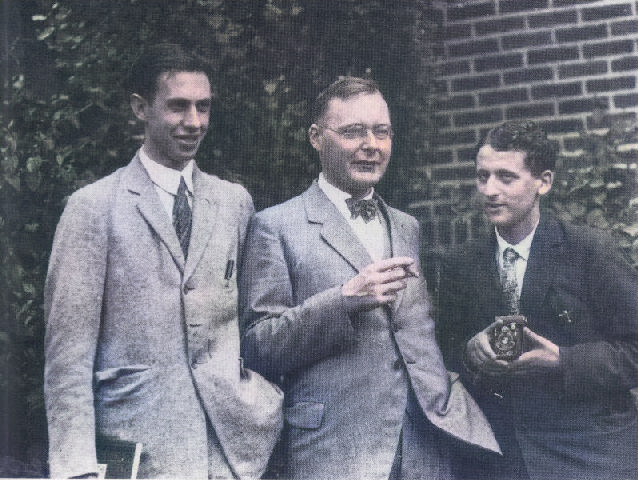
George Uhlenbeck (1900-1988), Hendrik Kramers, and Samuel Goudsmit circa 1928 in Ann Arbor.
On July 11, 1902, Dutch-born U.S. physicist Samuel Abraham Goudsmit was born. He is best known for the formulation of the concept of electron spin together with George Eugene Uhlenbeck. It led to recognition that spin was a property of protons, neutrons, and most elementary particles and to a fundamental change in the mathematical structure of quantum mechanics.
“I did all the problems a little different from the rest of the class.”
– Samuel Goudsmit, in an interview by Thomas Samuel Kuhn on December 5, 1963
The Electron Spin
If you not happen to be a physicist, you probably will never have heard that electrons have a spin. Well, electrons are not literally spinning balls of charge, but they do have intrinsic angular momentum. Spin angular momentum is real angular momentum. The angular momentum of a spin-1/2 particle like an electron is never zero. But, let’s go back one more step. In 1891, the Irish physicist, George Stoney, believed that electricity should have a fundamental unit. He called this unit the electron and the electron as the first sub-atomic particle was discovered by J.J. Thomson in 1897. Besides its electric charge and mass, an electron has one more key property, which is called “electron spin“.[6]
Two types of experimental evidence which arose in the 1920s suggested this additional property of the electron. One was the closely spaced splitting of the hydrogen spectral lines, called fine structure. The other was the Stern-Gerlach experiment which showed in 1922 that a beam of silver atoms directed through an inhomogeneous magnetic field would be forced into two beams. Both of these experimental situations were consistent with the possession of an intrinsic angular momentum and a magnetic moment by individual electrons. Classically this could occur if the electron were a spinning ball of charge, and this property was called electron spin.
Samuel Goudsmit – Background and Education
Samuel Goudsmit was born in The Hague, Netherlands, as son of Jewish parents Isaac and Marianne Goudsmit. As he was proud to claim throughout his life, his father was a small manufacturer of water closets fixtures while his mother ran a millinery shop. Samuel Goudsmit started his professional life at the University of Leyden during the earliest days of quantum mechanics as a student of Paul Ehrenfest,[5] a theoretical physicist, who made major contributions to the field of statistical mechanics and its relations with quantum mechanics. Ehrenfest was both, an outstanding scientist as well as a gifted pedagogue. Under Ehrenfest’s tutelage Goudsmit published his first scientific paper already at age 19 in 1921 in the prestigious journal “Die Naturwissenschaften“. In 1925 Goudsmit together with his fellow graduate student George Uhlenbeck were assigned by Ehrenfest to work for a quick update on “what was currently happening in physics“.
Young enough to Afford a Stupidity
Thus, while being a graduate student, Goudsmit and Uhlenbeck discovered the spin on the electron. Samuel Goudsmit and George Uhlenbeck proposed in 1925 to attribute an additional intrinsic angular momentum spin to the electron. As for the reception of this daring idea, it should be noted that its two originators immediately shrank back and tried to prevent the already prepared publication once again. However, their head of the institute, Paul Ehrenfest, forbade them to do so on the grounds: “They are both young enough to be able to afford a stupidity.”
Academic Career
In 1927 after receiving their PhD, Goudsmit and Uhlenbeck together moved to the United States where they continued their physics careers until death. Goudsmit was Associate Professor from 1927 and Professor at the University of Michigan from 1932. After the war, he was a professor at Northwestern University from 1946 to 1948 and then went to Brookhaven National Laboratory as a senior scientist in 1948, where he remained until his retirement in 1970. He lectured at the New School for Social Research in New York City (1948 to 1951), the United States Navy Bureau of Ships (1949 to 1959), the Rockefeller Institute (1957 to 1974), and the University of Nevada at Reno (1975 to 1978), among others.
The Alsos Mission
Goudsmit was also the scientific head of the Alsos Mission and successfully reached the German group of nuclear physicists around Werner Heisenberg and Otto Hahn at Hechingen (then French zone) in advance of the French physicist Yves Rocard. As part of the Manhattan Project, Alsos was designed to assess the progress of the Nazi atomic bomb project. Goudsmit published in 1947 his conclusion that the Germans did not get close to creating a weapon, which he attributed to the inability of science to function under a totalitarian state. His other conclusion, that the German scientists simply did not understand how to make an atomic bomb, has been disputed by later historians.
David Sherill, Introduction to Electron Spin Part 1, [9]
References and Further Reading:
- [1] Electron Spin for Toddlers – Uncertainty Principle, Science Blogs
- [2] Electron Spin at Hyperphysics
- [3] What is Electron Spin?
- [4] S.A.Goudsmit: The Discovery of the Electron Spin
- [5] Statistical Mechanics with Paul Ehrenfest, SciHi Blog
- [6] J.J. Thompson and the Electron, SciHi Blog
- [7] National Academy of Sciences Biographical Memoir
- [8] Samuel Goudsmit at Wikidata
- [9] David Sherill, Introduction to Electron Spin Part 1, David Sherrill@ youtube
- [10] “Goudsmit, Samuel A. (Samuel Abraham), 1902-1978”. AIP.org. American Institute of Physics, Physics History Network.
- [11] Goldhaber, Maurice (April 1979). “Obituary: Samuel A. Goudsmit”. Physics Today. 32 (4): 71–72.
- [12] “S.A. Goudsmit (1902 – 1978)”. Royal Netherlands Academy of Arts and Sciences.
- [13] Samuel Goudsmit Timeline via Wikidata

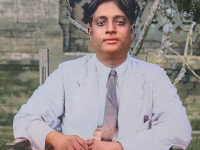
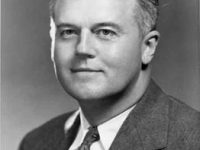
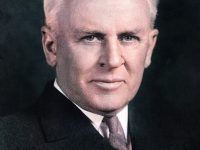
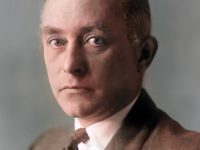

Pingback: Whewell’s Gazette: Year 3, Vol. #48 | Whewell's Ghost